Yung Y.L., DeMore W.B. Photochemistry of Planetary Atmospheres
Подождите немного. Документ загружается.

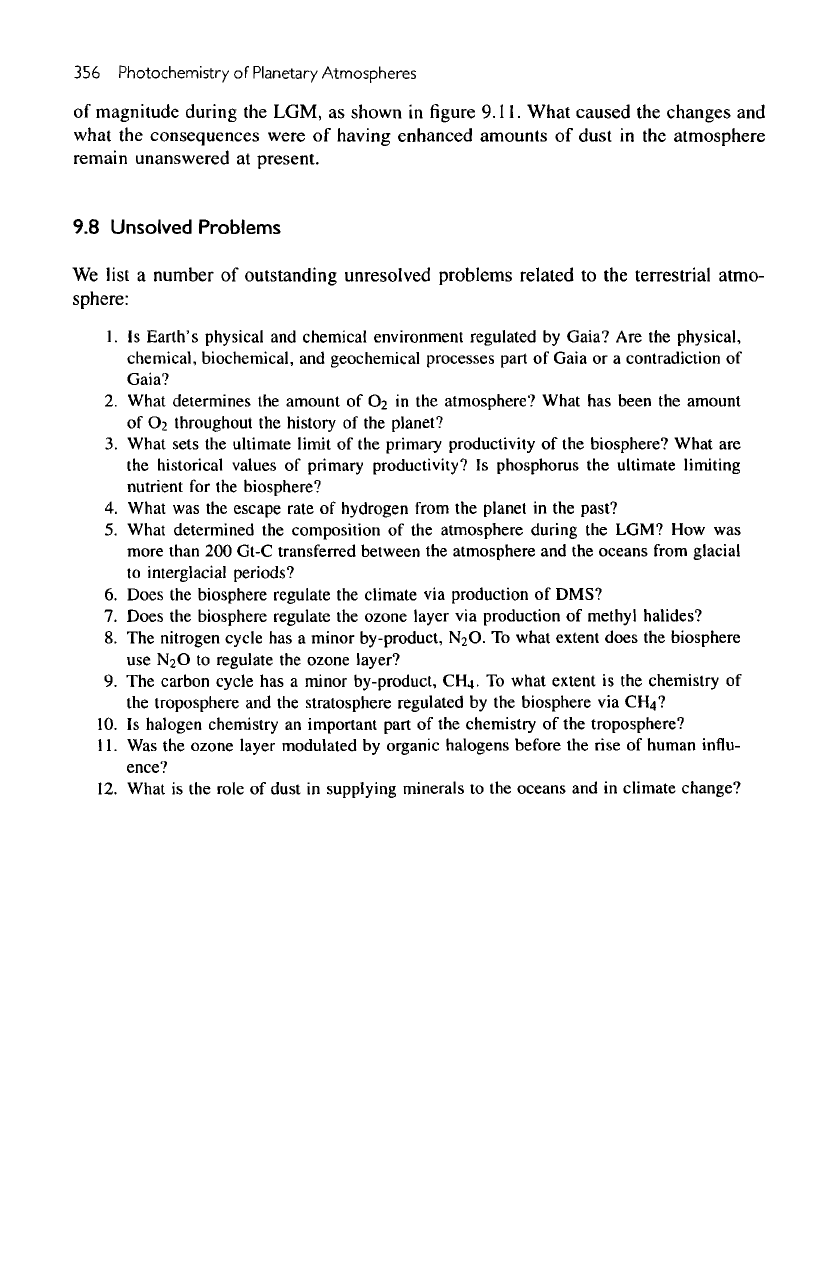
356
Photochemistry
of
Planetary
Atmospheres
of
magnitude
during
the
LGM,
as
shown
in
figure
9.11.
What
caused
the
changes
and
what
the
consequences
were
of
having
enhanced
amounts
of
dust
in the
atmosphere
remain
unanswered
at
present.
9.8
Unsolved
Problems
We
list
a
number
of
outstanding
unresolved
problems
related
to the
terrestrial
atmo-
sphere:
1.
Is
Earth's physical
and
chemical environment regulated
by
Gaia?
Are the
physical,
chemical,
biochemical,
and
geochemical processes part
of
Gaia
or a
contradiction
of
Gaia?
2.
What determines
the
amount
of
C>2
in the
atmosphere? What
has
been
the
amount
of 02
throughout
the
history
of the
planet?
3.
What
sets
the
ultimate
limit
of the
primary productivity
of the
biosphere?
What
are
the
historical values
of
primary productivity?
Is
phosphorus
the
ultimate limiting
nutrient
for the
biosphere?
4.
What
was the
escape
rate
of
hydrogen
from
the
planet
in the
past?
5.
What determined
the
composition
of the
atmosphere during
the
LGM?
How was
more than
200
Gt-C transferred between
the
atmosphere
and the
oceans from glacial
to
interglacial periods?
6.
Does
the
biosphere regulate
the
climate
via
production
of
DMS?
7.
Does
the
biosphere regulate
the
ozone layer
via
production
of
methyl halides?
8. The
nitrogen cycle
has a
minor by-product, N2O.
To
what extent
does
the
biosphere
use
NaO
to
regulate
the
ozone layer?
9. The
carbon cycle
has a
minor by-product,
CHa.
To
what extent
is the
chemistry
of
the
troposphere
and the
stratosphere regulated
by the
biosphere
via
CH4?
10. Is
halogen chemistry
an
important part
of the
chemistry
of the
troposphere?
11.
Was the
ozone
layer modulated
by
organic halogens before
the rise of
human
influ-
ence?
12.
What
is the
role
of
dust
in
supplying minerals
to the
oceans
and in
climate change?
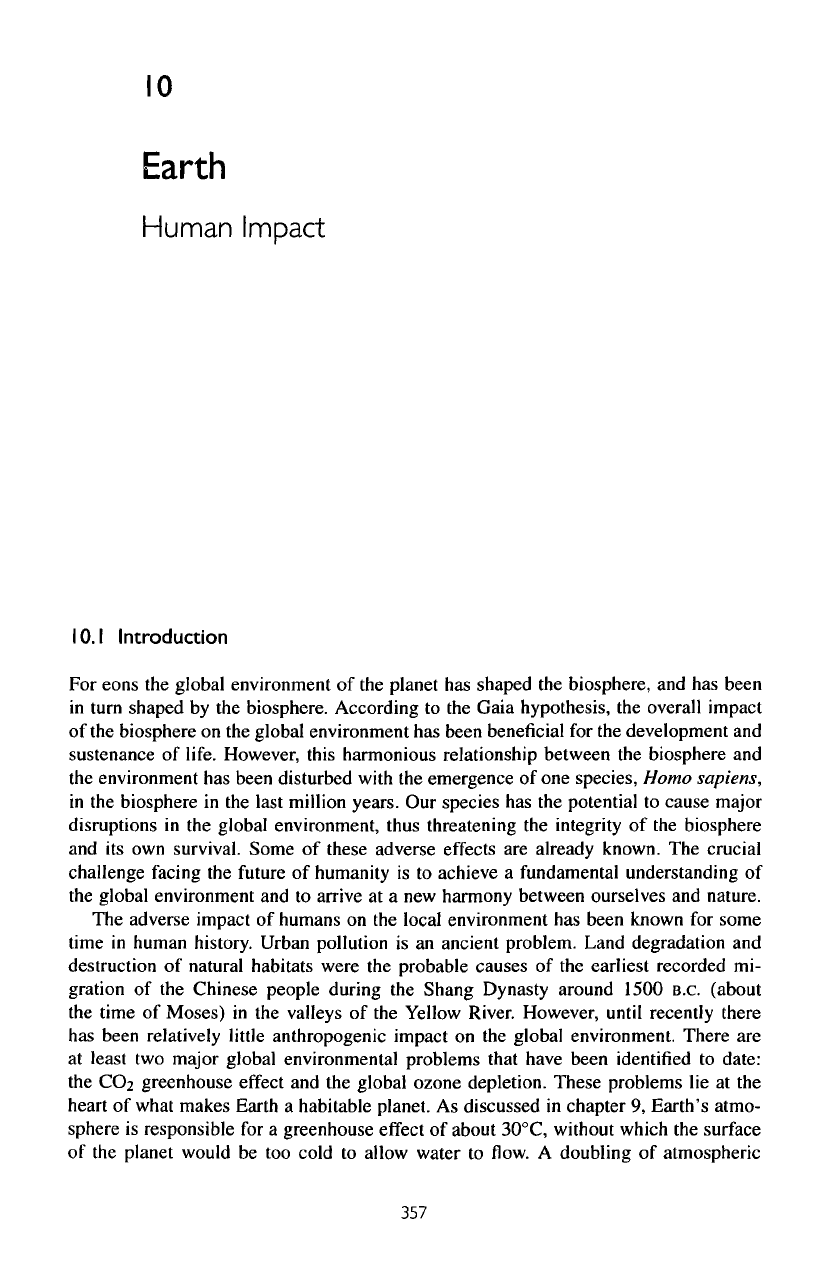
10
Earth
Human Impact
10.1
Introduction
For
eons
the
global environment
of the
planet
has
shaped
the
biosphere,
and has
been
in
turn
shaped
by the
biosphere. According
to the
Gaia hypothesis,
the
overall impact
of the
biosphere
on the
global environment
has
been beneficial
for the
development
and
sustenance
of
life.
However,
this
harmonious relationship between
the
biosphere
and
the
environment
has
been disturbed
with
the
emergence
of one
species, Homo sapiens,
in
the
biosphere
in the
last
million
years.
Our
species
has the
potential
to
cause major
disruptions
in the
global environment, thus threatening
the
integrity
of the
biosphere
and
its own
survival.
Some
of
these adverse
effects
are
already known.
The
crucial
challenge
facing
the
future
of
humanity
is to
achieve
a
fundamental
understanding
of
the
global environment
and to
arrive
at a new
harmony between ourselves
and
nature.
The
adverse impact
of
humans
on the
local environment
has
been known
for
some
time
in
human
history. Urban
pollution
is an
ancient problem. Land degradation
and
destruction
of
natural
habitats were
the
probable causes
of the
earliest recorded
mi-
gration
of the
Chinese people during
the
Shang Dynasty around 1500 B.C. (about
the
time
of
Moses)
in the
valleys
of the
Yellow River. However,
until
recently there
has
been
relatively
little
anthropogenic impact
on the
global environment.
There
are
at
least
two
major
global environmental problems that have been
identified
to
date:
the
CC>2
greenhouse
effect
and the
global ozone depletion.
These
problems
lie at the
heart
of
what
makes Earth
a
habitable planet.
As
discussed
in
chapter
9,
Earth's atmo-
sphere
is
responsible
for a
greenhouse
effect
of
about
30°C,
without
which
the
surface
of
the
planet would
be too
cold
to
allow water
to flow. A
doubling
of
atmospheric
357
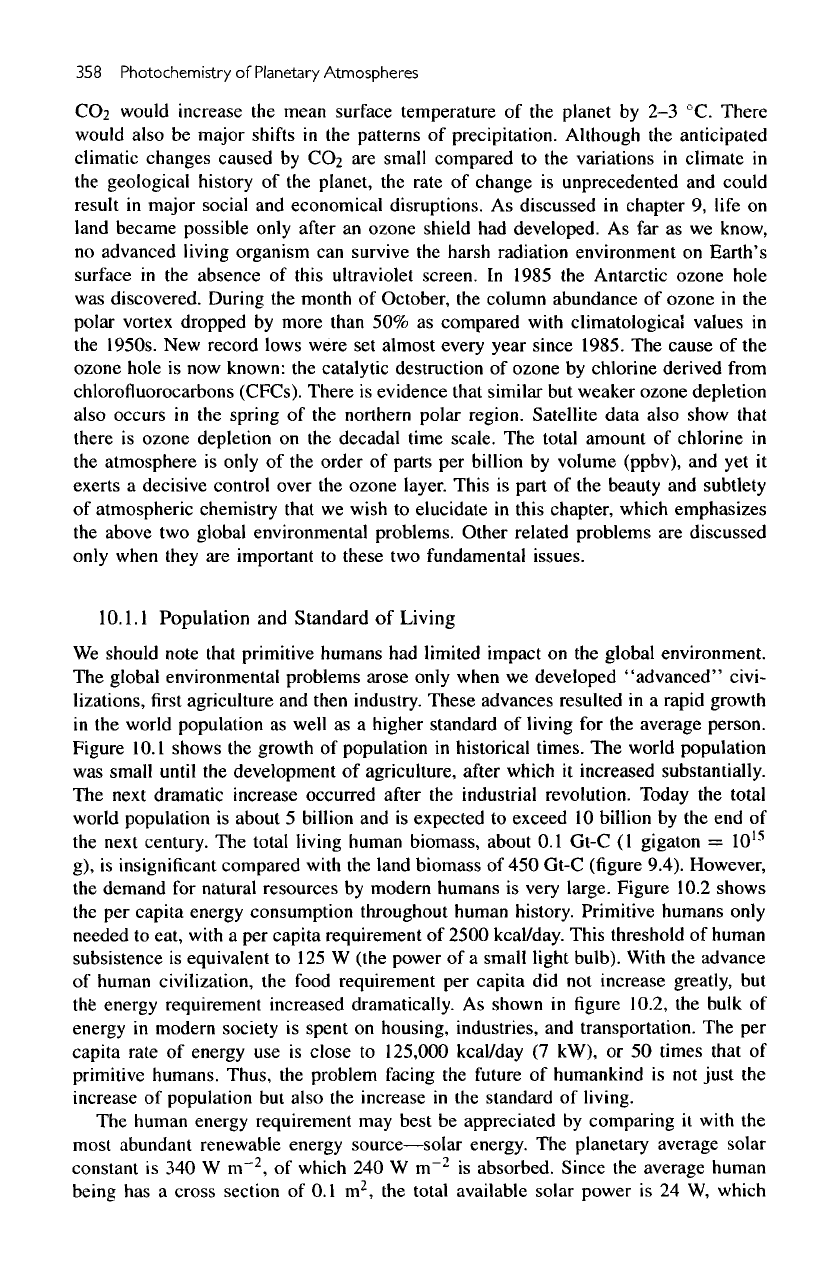
358
Photochemistry
of
Planetary
Atmospheres
CO2
would increase
the
mean surface temperature
of the
planet
by 2-3
°C.
There
would
also
be
major
shifts
in the
patterns
of
precipitation. Although
the
anticipated
climatic
changes caused
by CO2 are
small
compared
to the
variations
in
climate
in
the
geological history
of the
planet,
the
rate
of
change
is
unprecedented
and
could
result
in
major social
and
economical disruptions.
As
discussed
in
chapter
9,
life
on
land became possible only after
an
ozone shield
had
developed.
As far as we
know,
no
advanced
living
organism
can
survive
the
harsh radiation environment
on
Earth's
surface
in the
absence
of
this ultraviolet screen.
In
1985
the
Antarctic
ozone
hole
was
discovered. During
the
month
of
October,
the
column abundance
of
ozone
in the
polar vortex dropped
by
more than
50% as
compared
with
climatologicai
values
in
the
1950s.
New
record lows were
set
almost every year since 1985.
The
cause
of the
ozone
hole
is now
known:
the
catalytic destruction
of
ozone
by
chlorine derived from
chlorofluorocarbons
(CFCs).
There
is
evidence that similar
but
weaker
ozone
depletion
also
occurs
in the
spring
of the
northern polar region. Satellite data also show
that
there
is
ozone depletion
on the
decadal time
scale.
The
total amount
of
chlorine
in
the
atmosphere
is
only
of the
order
of
parts
per
billion
by
volume (ppbv),
and yet it
exerts
a
decisive control over
the
ozone layer. This
is
part
of the
beauty
and
subtlety
of
atmospheric chemistry that
we
wish
to
elucidate
in
this chapter, which emphasizes
the
above
two
global environmental problems. Other related
problems
are
discussed
only
when they
are
important
to
these
two
fundamental issues.
10.1.1
Population
and
Standard
of
Living
We
should note
that
primitive humans
had
limited impact
on the
global
environment.
The
global environmental problems
arose
only when
we
developed
"advanced"
civi-
lizations,
first
agriculture
and
then industry.
These
advances resulted
in a
rapid growth
in
the
world population
as
well
as a
higher standard
of
living
for the
average
person.
Figure
10.1
shows
the
growth
of
population
in
historical times.
The
world population
was
small
until
the
development
of
agriculture, after which
it
increased substantially.
The
next dramatic increase
occurred
after
the
industrial revolution. Today
the
total
world population
is
about
5
billion
and is
expected
to
exceed
10
billion
by the end of
the
next
century.
The
total living human biomass, about
0.1
Gt-C
(1
gigaton
=
10
15
g), is
insignificant
compared with
the
land
biomass
of 450
Gt-C (figure 9.4). However,
the
demand
for
natural
resources
by
modern humans
is
very large. Figure 10.2 shows
the
per
capita energy consumption throughout human history. Primitive humans only
needed
to
eat,
with
a per
capita requirement
of
2500
kcal/day.
This threshold
of
human
subsistence
is
equivalent
to 125 W
(the power
of a
small light bulb). With
the
advance
of
human civilization,
the
food requirement
per
capita
did not
increase greatly,
but
the
energy requirement increased dramatically.
As
shown
in figure
10.2,
the
bulk
of
energy
in
modern society
is
spent
on
housing, industries,
and
transportation.
The per
capita rate
of
energy
use is
close
to
125,000
kcal/day
(7
kW),
or 50
times
that
of
primitive
humans. Thus,
the
problem facing
the
future
of
humankind
is not
just
the
increase
of
population
but
also
the
increase
in the
standard
of
living.
The
human energy requirement
may
best
be
appreciated
by
comparing
it
with
the
most abundant renewable energy
source—solar
energy.
The
planetary average solar
constant
is 340 W
m~~
2
,
of
which
240 W
m~
2
is
absorbed. Since
the
average human
being
has a
cross
section
of 0.1
m
2
,
the
total available solar power
is 24 W,
which
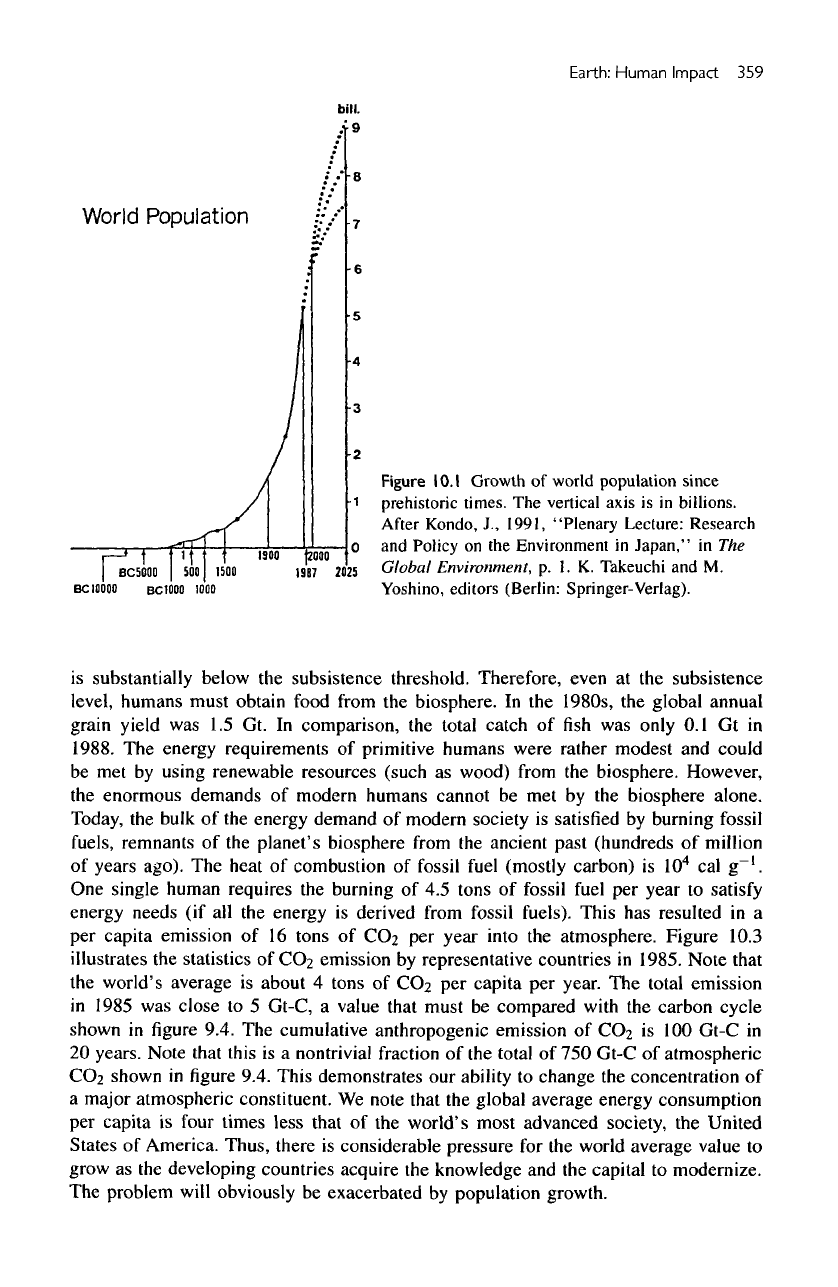
Earth:
Human
Impact
359
Figure
10.1
Growth
of
world population
since
prehistoric
times.
The
vertical axis
is in
billions.
After
Kondo,
J.,
1991,
"Plenary
Lecture: Research
and
Policy
on the
Environment
in
Japan,"
in The
Global Environment,
p. 1. K.
Takeuchi
and
M.
Yoshino,
editors (Berlin:
Springer-Verlag).
is
substantially below
the
subsistence threshold. Therefore, even
at the
subsistence
level, humans must obtain food from
the
biosphere.
In the
1980s,
the
global annual
grain yield
was 1.5 Gt. In
comparison,
the
total catch
of fish was
only
0.1
Gt in
1988.
The
energy requirements
of
primitive humans were rather modest
and
could
be met by
using renewable
resources
(such
as
wood) from
the
biosphere. However,
the
enormous
demands
of
modern humans cannot
be met by the
biosphere
alone.
Today,
the
bulk
of the
energy demand
of
modern society
is
satisfied
by
burning fossil
fuels,
remnants
of the
planet's biosphere
from
the
ancient past (hundreds
of
million
of
years ago).
The
heat
of
combustion
of
fossil
fuel
(mostly carbon)
is
10
4
cal
g~'.
One
single human requires
the
burning
of 4.5
tons
of
fossil
fuel
per
year
to
satisfy
energy needs
(if all the
energy
is
derived from fossil fuels). This
has
resulted
in a
per
capita emission
of 16
tons
of
CC>2
per
year into
the
atmosphere. Figure 10.3
illustrates
the
statistics
of
CC>2
emission
by
representative countries
in
1985. Note that
the
world's average
is
about
4
tons
of CO2 per
capita
per
year.
The
total emission
in
1985
was
close
to 5
Gt-C,
a
value that must
be
compared
with
the
carbon cycle
shown
in figure
9.4.
The
cumulative anthropogenic emission
of
COa
is 100
Gt-C
in
20
years. Note
that
this
is a
nontrivial
fraction
of the
total
of 750
Gt-C
of
atmospheric
CO
2
shown
in figure
9.4. This demonstrates
our
ability
to
change
the
concentration
of
a
major atmospheric constituent.
We
note
that
the
global average energy consumption
per
capita
is
four times
less
that
of the
world's
most
advanced
society,
the
United
States
of
America. Thus, there
is
considerable pressure
for the
world average value
to
grow
as the
developing countries acquire
the
knowledge
and the
capital
to
modernize.
The
problem will obviously
be
exacerbated
by
population growth.
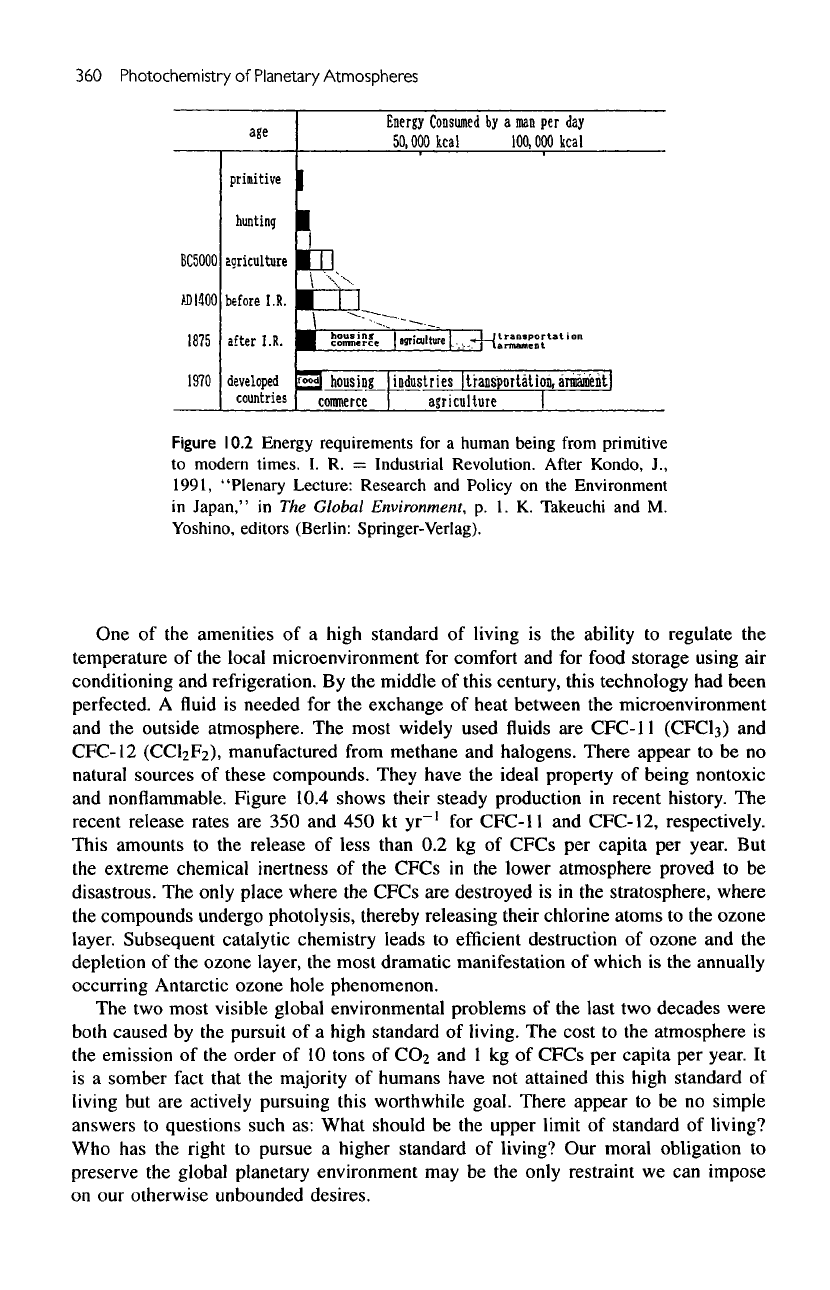
360
Photochemistry
of
Planetary
Atmospheres
Figure
10.2
Energy requirements
for a
human being
from
primitive
to
modern times.
I. R. =
Industrial
Revolution.
After
Kondo,
J.,
1991,
"Plenary
Lecture: Research
and
Policy
on the
Environment
in
Japan,"
in The
Global Environment,
p. 1.
K.
Takeuchi
and M.
Yoshino,
editors (Berlin:
Springer-Verlag).
One of the
amenities
of a
high standard
of
living
is the
ability
to
regulate
the
temperature
of the
local microenvironment
for
comfort
and for
food storage
using
air
conditioning
and
refrigeration.
By the
middle
of
this century, this technology
had
been
perfected.
A fluid is
needed
for the
exchange
of
heat between
the
microenvironment
and
the
outside atmosphere.
The
most widely used
fluids are
CFC-11
(CFCb)
and
CFC-12
(CC12F2), manufactured
from
methane
and
halogens.
There
appear
to be no
natural
sources
of
these compounds. They have
the
ideal property
of
being nontoxic
and
nonflammable. Figure 10.4 shows their steady production
in
recent history.
The
recent
release rates
are 350 and 450 kt
yr~'
for
CFC-11
and
CFC-12,
respectively.
This amounts
to the
release
of
less than
0.2 kg of
CFCs
per
capita
per
year.
But
the
extreme chemical inertness
of the
CFCs
in the
lower atmosphere proved
to be
disastrous.
The
only place where
the
CFCs
are
destroyed
is in the
stratosphere, where
the
compounds undergo photolysis, thereby releasing their chlorine atoms
to the
ozone
layer.
Subsequent catalytic chemistry leads
to
efficient
destruction
of
ozone
and the
depletion
of the
ozone
layer,
the
most dramatic manifestation
of
which
is the
annually
occurring
Antarctic ozone hole phenomenon.
The two
most visible global environmental problems
of the
last
two
decades were
both
caused
by the
pursuit
of a
high standard
of
living.
The
cost
to the
atmosphere
is
the
emission
of the
order
of 10
tons
of
COa
and 1 kg of
CFCs
per
capita
per
year.
It
is
a
somber
fact
that
the
majority
of
humans have
not
attained this
high
standard
of
living
but are
actively pursuing
this
worthwhile goal.
There
appear
to be no
simple
answers
to
questions such
as:
What should
be the
upper
limit
of
standard
of
living?
Who
has the
right
to
pursue
a
higher standard
of
living?
Our
moral obligation
to
preserve
the
global planetary environment
may be the
only restraint
we can
impose
on
our
otherwise unbounded desires.
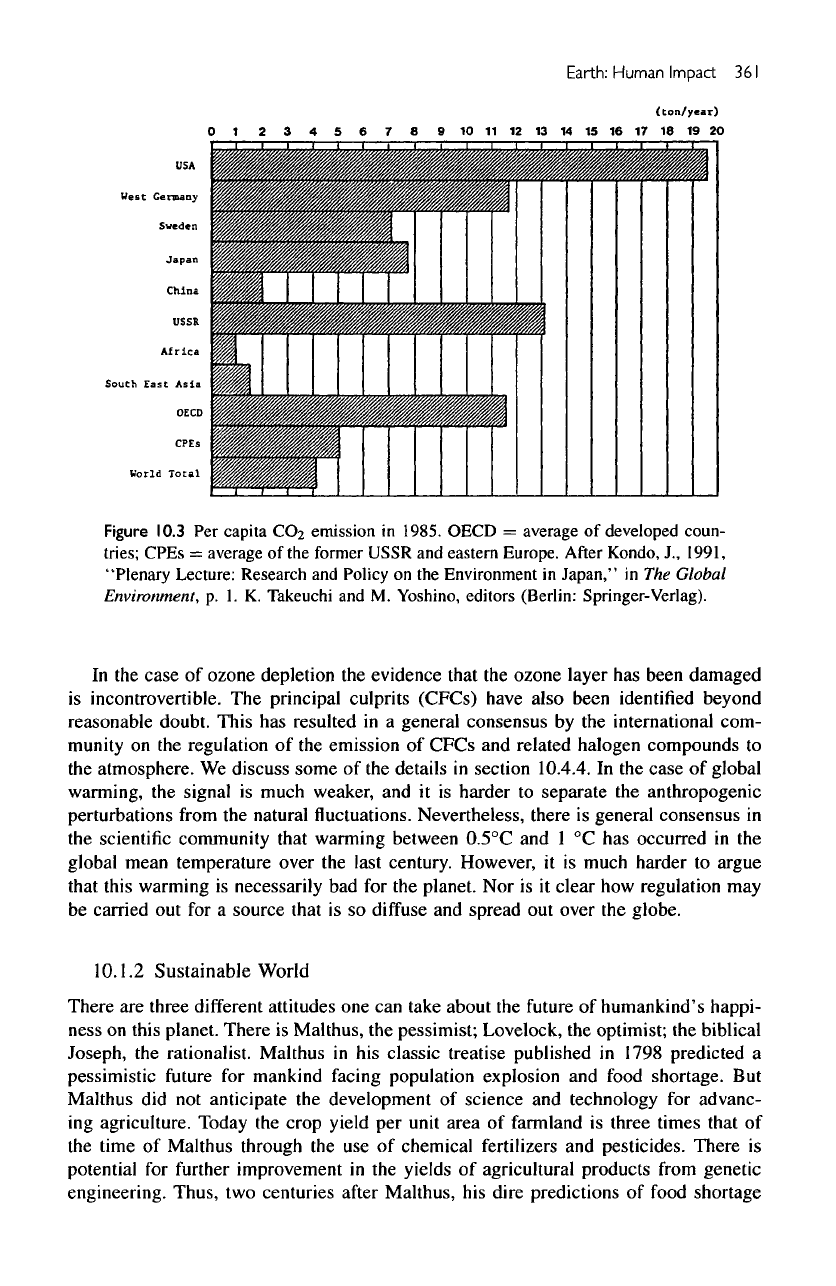
Earth:
Human
Impact
361
Figure
10.3
Per
capita
CC>2
emission
in
1985.
OECD
=
average
of
developed coun-
tries;
CPEs
=
average
of the
former USSR
and
eastern Europe.
After
Kondo,
J.,
1991,
"Plenary
Lecture: Research
and
Policy
on the
Environment
in
Japan,"
in The
Global
Environment,
p. 1.
K.
Takeuchi
and
M.
Yoshino,
editors (Berlin:
Springer-Verlag).
In
the
case
of
ozone depletion
the
evidence that
the
ozone
layer
has
been damaged
is
incontrovertible.
The
principal culprits
(CFCs)
have
also
been
identified
beyond
reasonable doubt. This
has
resulted
in a
general consensus
by the
international com-
munity
on the
regulation
of the
emission
of
CFCs
and
related halogen compounds
to
the
atmosphere.
We
discuss
some
of the
details
in
section
10.4.4.
In the
case
of
global
warming,
the
signal
is
much weaker,
and it is
harder
to
separate
the
anthropogenic
perturbations
from
the
natural
fluctuations.
Nevertheless, there
is
general consensus
in
the
scientific
community that warming between
0.5°C
and 1 °C has
occurred
in the
global mean temperature over
the
last century. However,
it is
much harder
to
argue
that
this
warming
is
necessarily
bad for the
planet.
Nor is it
clear
how
regulation
may
be
carried
out for a
source that
is so
diffuse
and
spread
out
over
the
globe.
10.1.2
Sustainable World
There
are
three
different
attitudes
one can
take about
the
future
of
humankind's happi-
ness
on
this planet. There
is
Malthus,
the
pessimist; Lovelock,
the
optimist;
the
biblical
Joseph,
the
rationalist. Malthus
in his
classic treatise published
in
1798 predicted
a
pessimistic
future
for
mankind facing population explosion
and
food shortage.
But
Malthus
did not
anticipate
the
development
of
science
and
technology
for
advanc-
ing
agriculture. Today
the
crop yield
per
unit
area
of
farmland
is
three times that
of
the
time
of
Malthus through
the use of
chemical
fertilizers
and
pesticides.
There
is
potential
for
further
improvement
in the
yields
of
agricultural products
from
genetic
engineering.
Thus,
two
centuries
after
Malthus,
his
dire predictions
of
food shortage
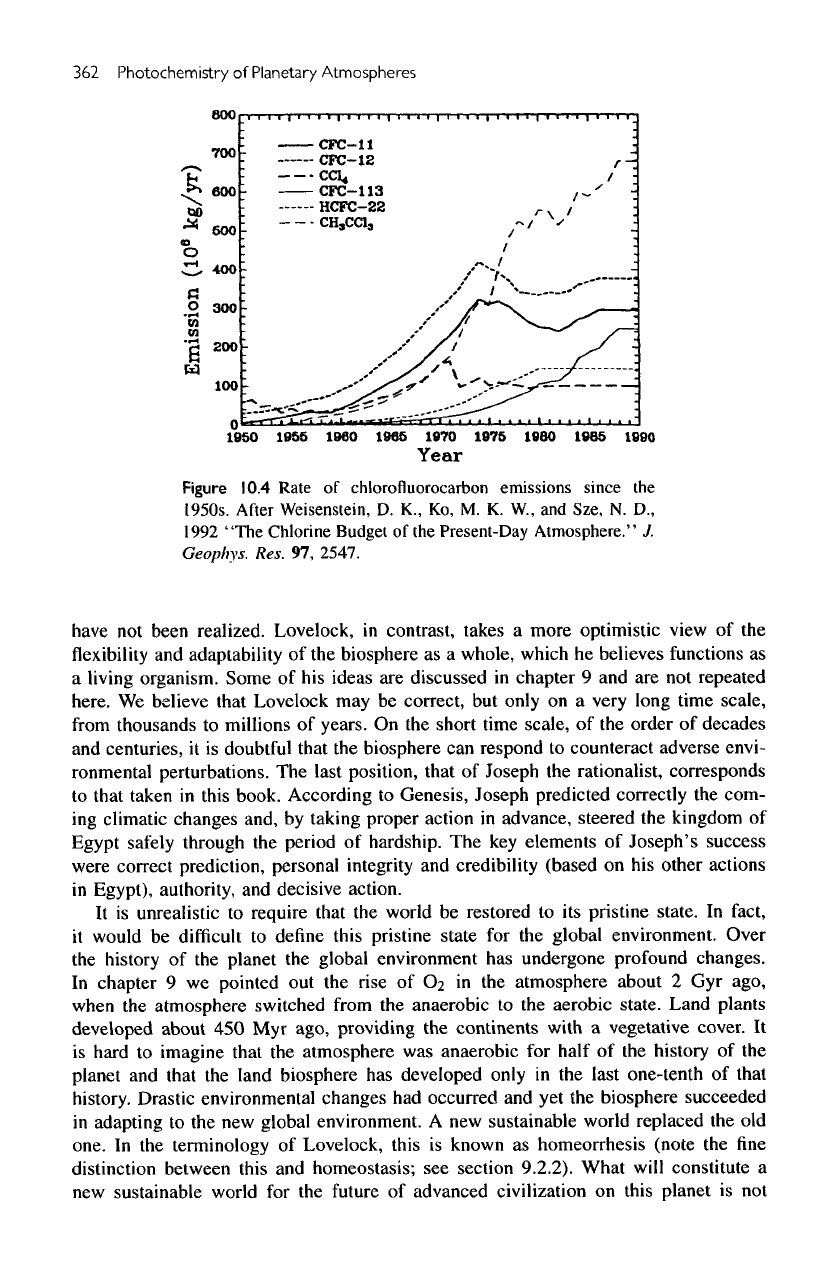
362
Photochemistry
of
Planetary
Atmospheres
Figure
10.4
Rate
of
chlorofluorocarbon
emissions
since
the
1950s.
After
Weisenstein,
D.
K.,
Ko,
M.
K. W., and
Sze,
N. D.,
1992 "The Chlorine Budget
of the
Present-Day
Atmosphere."
J.
Geophys.
Res.
97,
2547.
have
not
been realized. Lovelock,
in
contrast, takes
a
more optimistic view
of the
flexibility
and
adaptability
of the
biosphere
as a
whole, which
he
believes functions
as
a
living
organism.
Some
of his
ideas
are
discussed
in
chapter
9 and are not
repeated
here.
We
believe
that Lovelock
may be
correct,
but
only
on a
very long time scale,
from
thousands
to
millions
of
years.
On the
short time scale,
of the
order
of
decades
and
centuries,
it is
doubtful
that
the
biosphere
can
respond
to
counteract adverse envi-
ronmental
perturbations.
The
last position, that
of
Joseph
the
rationalist,
corresponds
to
that taken
in
this book. According
to
Genesis, Joseph predicted correctly
the
com-
ing
climatic changes and,
by
taking proper action
in
advance, steered
the
kingdom
of
Egypt safely through
the
period
of
hardship.
The key
elements
of
Joseph's
success
were correct prediction, personal integrity
and
credibility (based
on his
other actions
in
Egypt),
authority,
and
decisive action.
It
is
unrealistic
to
require that
the
world
be
restored
to its
pristine state.
In
fact,
it
would
be
difficult
to
define
this
pristine
state
for the
global environment. Over
the
history
of the
planet
the
global environment
has
undergone profound changes.
In
chapter
9 we
pointed
out the
rise
of 02 in the
atmosphere about
2 Gyr
ago,
when
the
atmosphere switched from
the
anaerobic
to the
aerobic state. Land plants
developed
about
450 Myr
ago, providing
the
continents
with
a
vegetative
cover.
It
is
hard
to
imagine that
the
atmosphere
was
anaerobic
for
half
of the
history
of the
planet
and
that
the
land biosphere
has
developed only
in the
last one-tenth
of
that
history.
Drastic environmental changes
had
occurred
and yet the
biosphere
succeeded
in
adapting
to the new
global environment.
A new
sustainable world replaced
the old
one.
In the
terminology
of
Lovelock, this
is
known
as
homeorrhesis
(note
the fine
distinction
between this
and
homeostasis;
see
section 9.2.2). What
will
constitute
a
new
sustainable world
for the
future
of
advanced civilization
on
this planet
is not

Earth:
Human
Impact
363
currently
resolved.
The
problem
will
remain unresolved
until
our
basic knowledge
of
the
planet's land, atmosphere,
and
oceans becomes better
defined.
It
is
perhaps
fortunate
that
population growth
and
achieving
a
high standard
of
living
do not
reinforce each other.
A
country burdened
with
a
large population cannot easily
achieve
a
high standard
of
living,
and a
society
that
has
achieved
a
high
standard
of
living
(and high level
of
literacy)
usually
does
not
increase
its
population. Hence, there
is
hope
that
a new
level
of
equilibrium
may be
reached,
as in the age of
agriculture,
with
a
stable world population
on a
sustainable planet.
10.2
Global
Warming
We
have only
a
short record
of the
quantitative
measurements
of the
surface temper-
ature
of
Earth based
on
instruments. Figure 10.5 shows
the
instrument-based mean
surface
temperature
of the
northern hemisphere, southern hemisphere,
and the
globe
from
1861
to
1989 relative
to the
1951-1980
climatological average.
The
data
all
con-
sistently
show
an
increasing trend.
A
linear
fit
between 1890
and
1989 gives values
of
0.47°C
(northern hemisphere),
0.53°C
(southern hemisphere),
and
0.50°C
(globe)
in
100 yr.
There
is a
period
of
rapid increase
in
temperature during
the
1920s.
A
cooling trend appears
in the
northern hemisphere data
in the
1960s.
Both hemispheres
exhibit
rapid wanning trends since 1970.
The
deduced warming trend
is
consistent
with
the
expected global warming
due to the
increase
of
greenhouse
gases.
The
short-
term
fluctuations,
such
as
that
in the
1970s,
are not
understood
but are
believed
to be
associated
with
large-scale ocean dynamics.
In
addition
to an
increase
of the
surface temperature, other changes
are
expected
to be
associated
with
global warming.
These
include changes
in
precipitation, cloudi-
ness, soil moisture,
and
frequency
of
storms.
We do not
have
a
sufficiently
accurate
century-old
global
record
of
these climate variables
to
check
for the
"fingerprints"
of
global warming
and to
calibrate
our
climate models.
The
best evidence
to
date
is
circumstantial
evidence
based
on a
limited
dataset
of the
temperature
of the
upper
troposphere
and the
stratosphere. Figure 10.6 shows
the
temperature anomalies
in the
troposphere
and the
lower stratosphere from 1958 through 1989.
Note
that while there
is
no
well-defined trend
in the
lower atmosphere,
the
upper troposphere
and the
lower
stratosphere show trends
of
-0.5
and
—2°C,
respectively.
This
is
consistent
with
the
predictions
of the
greenhouse
effect.
The
same molecules that raise
the
surface tem-
perature
of the
planet
by
blocking
the
infrared emission
are
also
efficient
radiators
in
the
upper atmosphere, where their enhanced radiation contributes
to a
cooling
of
the
atmosphere. However,
no
quantitative
comparison between
the
observations
and
model calculations
has
been made.
10.2.1
Greenhouse
Gases
The
principal greenhouse molecules
in the
terrestrial atmosphere
are
summarized
in
table
10.1,
along
with
their current
and
preindustrial
concentrations, rates
of
accumu-
lation,
and
lifetimes.
The five
gases
listed
in
table 10.1,
CO
2
,
CH
4
,
CFC-11,
CFC-12,
and
N2O,
are
believed
to be
primarily
responsible
for the 100 yr
temperature trend
deduced from
figure
10.5. Water vapor
is
actually
the
most important greenhouse
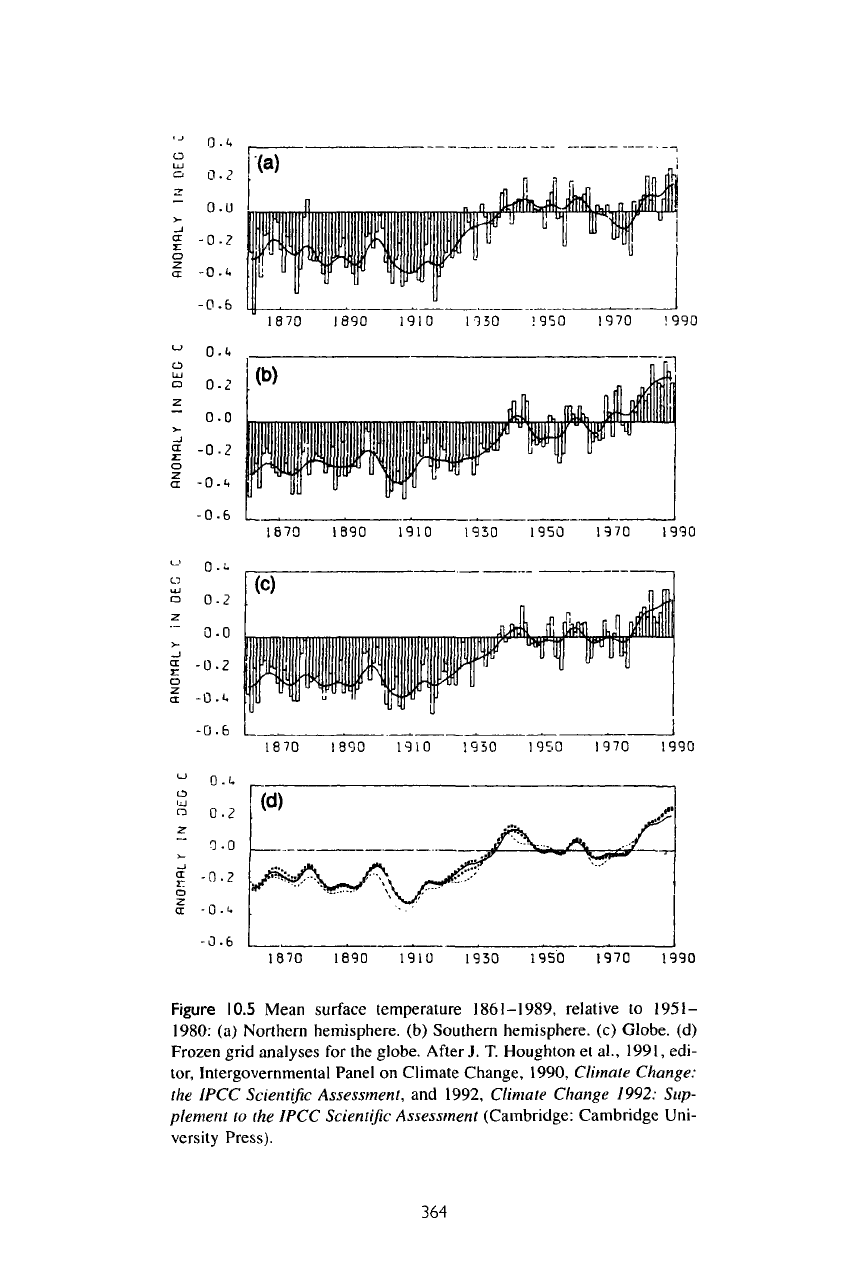
Figure
10.5
Mean surface temperature
1861-1989,
relative
to
1951-
1980:
(a)
Northern
hemisphere,
(b)
Southern
hemisphere,
(c)
Globe,
(d)
Frozen
grid
analyses
for the
globe.
After
J. T.
Houghton
et
al.,
1991, edi-
tor,
Intergovernmental
Panel
on
Climate Change, 1990,
Climate
Change:
the
1PCC
Scientific
Assessment,
and
1992, Climate
Change
1992:
Sup-
plement
to
the
IPCC
Scientific
Assessment
(Cambridge: Cambridge Uni-
versity
Press).
364
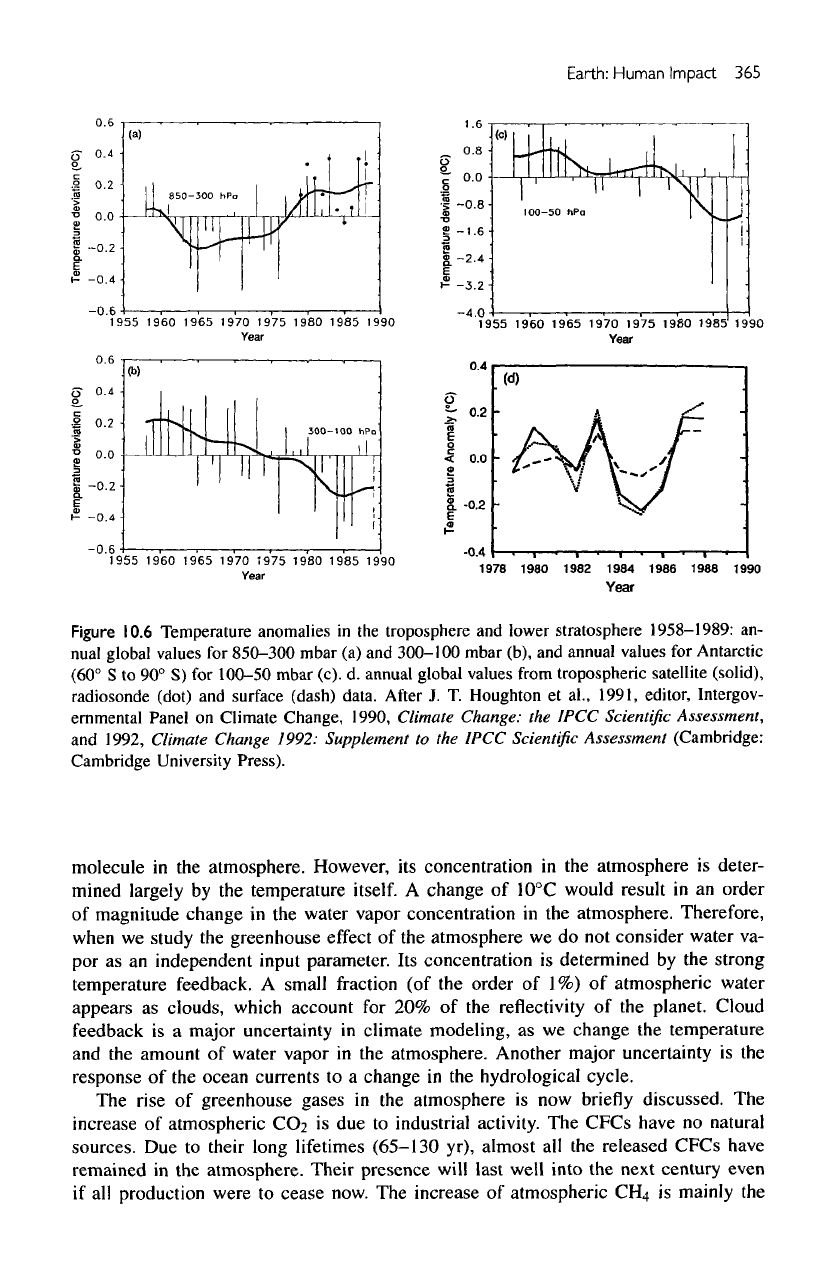
Earth:
Human
Impact
365
Figure
10.6
Temperature anomalies
in the
troposphere
and
lower stratosphere
1958-1989:
an-
nual
global values
for
850-300
mbar
(a) and
300-100
mbar (b),
and
annual
values
for
Antarctic
(60°
S to 90° S) for
100-50
mbar (c).
d.
annual
global
values from
tropospheric
satellite
(solid),
radiosonde (dot)
and
surface (dash) data.
After
J. T.
Houghton
et
al.,
1991,
editor, Intergov-
ernmental
Panel
on
Climate Change, 1990, Climate Change:
the
IPCC
Scientific
Assessment,
and
1992, Climate Change 1992: Supplement
to the
IPCC
Scientific
Assessment
(Cambridge:
Cambridge
University
Press).
molecule
in the
atmosphere. However,
its
concentration
in the
atmosphere
is
deter-
mined
largely
by the
temperature itself.
A
change
of
10°C would result
in an
order
of
magnitude change
in the
water vapor concentration
in the
atmosphere. Therefore,
when
we
study
the
greenhouse
effect
of the
atmosphere
we do not
consider water
va-
por as an
independent
input
parameter.
Its
concentration
is
determined
by the
strong
temperature feedback.
A
small
fraction
(of the
order
of 1%) of
atmospheric water
appears
as
clouds, which account
for 20% of the
reflectivity
of the
planet. Cloud
feedback
is a
major uncertainty
in
climate modeling,
as we
change
the
temperature
and
the
amount
of
water vapor
in the
atmosphere. Another major uncertainty
is the
response
of the
ocean currents
to a
change
in the
hydrological
cycle.
The
rise
of
greenhouse
gases
in the
atmosphere
is now
briefly
discussed.
The
increase
of
atmospheric
CC>2
is due to
industrial
activity.
The
CFCs
have
no
natural
sources.
Due to
their
long
lifetimes
(65-130
yr), almost
all the
released
CFCs
have
remained
in the
atmosphere.
Their
presence
will last
well
into
the
next century even
if
all
production were
to
cease now.
The
increase
of
atmospheric
CHj
is
mainly
the
